|
|
Minting

|
|
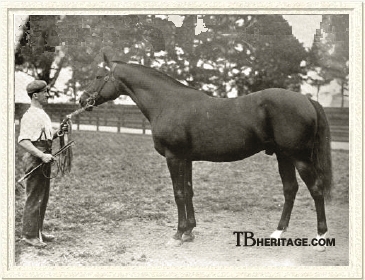 |
|
|
Although he did not win an English classic, Minting qualifies as a very good race horse, but not quite as good as another colt born in the same year -- Ormonde, a leading candidate for the best runner of the nineteenth century. Minting was born towards the end of his sire's stud career, after pretty much all expectations of seeing a superior Lord Lyon son had vanished. Miles above Lord Lyon's other colts in class, great things were expected of him in the stud, but none of Minting's foals were anywhere near his quality on the turf. Two sons continued his sire line -- in the U.S., and South Africa -- for a couple of generations, but the descendants of his daughters are the ones seen on the turf today.
|
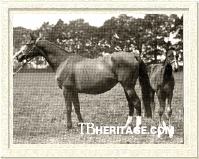
Mint Sauce | | Minting's dam, Mint Sauce, was a "massive, bony mare" by Young Melbourne, a one-race son of Melbourne who made the most of his limited opportunities at stud. Her dam, Sycee, was, unlike her daughter, a "small, neat-looking mare." Mint Sauce won one race (while in foal), a welter handicap for gentleman riders at Kelso, in two seasons on the turf. She was a broodmare for Clare Vyner, a wealthy northern sportsman, and when he died, she went into the Yorkshire stud of his brother, Robert Charles Vyner, owner of over 38,000 acres in three northern counties, and a big supporter of northern racing, and a steward at many courses. In addition to Minting, Mint Sauce produced Doncaster St. Leger winner The Lambkin (also bequeathed by Clare to Robert Vyner, as was his sire, Camballo), and One Thousand Guineas winner Minthe (by Camballo).
|
His sire, Lord Lyon (1863) was a courageous horse that won seventeen (including a dead-heat and a forfeit) of his twenty-one starts, including all three classic races, making him England's third winner of what became known as the Triple Crown. Lord Lyon inherited his stoutness from his sire, Stockwell, "the Emperor of Stallions," and his speed from his dam, Paradigm (1852), who produced a series of other good winners, none of which, with the exception of Lord Lyon's dual-classic winning sister, Achievement, could win much beyond a mile. Despite his success on the turf, Lord Lyon was largely a failure at stud. He got one classic winner, Placida, that took the Epsom Oaks, but later proved to be best at a mile. Most of his offspring, with few exceptions, ran at selling plate level, usually at a mile or less. His two best racing sons -- Minting and Touchet (1874) -- continued his sire line for a few generations. His daughters were useful in the breeding shed: dual classic winner Mimi (by Barcaldine) and Prix du Jockey Club winner Ermak were out of Lord Lyon mares.
Minting, born at Vyner's Fairfield Stud in Yorkshire, was a great, big yearling, but "so well posed and set on his legs that he was an active horse, and could jump off the mark and get into his stride with as much smartness as the slimmest filly." Like Lord Lyon, "there was ever trouble...with his feet...throughout his racing career [they] were kept fairly right by great attention, but for many years after he went to the stud he could not be bedded on straw." Closing on 17 hands, he was the biggest good racehorse seen to that date, but all parts were in proportion, and many commented on how handsome he was, with enormous bone below the knee. He had superior speed, a huge length of stride, and was a great weight-carrier. At stud, he was "ever the gentleman," with a good temperament.
|
Minting on the Turf
Vyner sent Minting to trainer Matt Dawson, who had long-time roots in Yorkshire, at Heath House, Newmarket, and for Dawson it was love at first sight. Minting was an unbeaten juvenile, winning five races: including Newcastle's Seaton Delaval Stakes (beating seven), Goodwood's Prince of Wales's Stakes (beating six), the Newmarket Triennial Produce Stakes, Doncaster's Champagne Stakes (beating five) and Newmarket's Middle Park Plate (beating the brave little filly Braw Lass, with the unbeaten Saraband third, and six others), the latter two premier two-year-old events. But looming large was Ormonde, who did not start until the fall, and missed meeting Minting at age two, weighing in with three winning races, including the Criterion Stakes and the Dewhurst Stakes. At the end of the season, Dawson, who "refused to believe that another equally good [as Minting] could have been foaled in the same year," considered Ormonde a "good second" kind of horse.
At age three, Ormonde and Minting first met in the Two Thousand Guineas, where Ormonde beat the big colt by two lengths. Prior to the race, the famous jockey Fred Archer, who had ridden Ormonde in a trial for trainer John Porter at Kingsclere, reported to Dawson and Vyner that he had never ridden "a horse more fit in my life." Dawson and Vyner had strategized to get Minting ready for the Guineas, but to not bring him to a peak, in order to save something for the Derby. The news that Ormonde was ready to go, from such an impeccable source as Archer, sent the Vyner stable into a panic, and a lot of money was placed on Ormonde to recoup the big wagers that had already been placed on Minting for the Guineas. George Watts, Minting's jockey for the Guineas, was instructed "not to ride him quite to the bitter end if Ormonde undoubtedly had the best of it at the finish," and so it happened. Dawson was reportedly so upset at Minting's loss, that he was not seen for a week after the race.
Dawson was still convinced Minting could beat Ormonde in the Derby, but Vyner was more cautious. In the end, because of the Ormonde threat; because the Grand Prix de Paris (1 mile-7 furlongs) was a more valuable race than the Derby, and its course more forgiving to big horses and the competition practically non-existent; because Vyner had, at the time, a grudge against all things French because of a sour property deal in France; and because Dawson had wagered heavily on Minting for the Derby, which looked an iffy proposition, Minting was shipped across the channel to run in the French race. Dawson was able to recoup his forfeited wager on the Derby by betting on Minting for the Grand Prix, which he won easily by five lengths.
Five days before the Eclipse Stakes in July, Minting was found staggering in his stall, only hours after the odds on him had risen signficantly. Dawson thought he had been poisoned, although only slightly, and wired Vyner that he thought the horse could still run. But that evening, Minting's leg swelled to the point of painful lameness, and he was scratched from the race. A stable hand, that hurridly left for France, was suspected, and later two frightened stable lads came forward to say Minting's leg had been bandaged by the suspect, and then hit with a hammer. Minting did not race again that season, and Dawson had to persuade Vyner to keep him in training, rather than retire him to stud.
In 1887, age four, Minting only ran at Ascot. On June 7 he won the one mile Jubilee Cup, giving St. Mirin ten pounds and beating Bendigo at even weights, with two others in the field. Then, three days later, he met Ormonde again (who had won the Rous Memorial the previous day), in the Hardwicke Stakes (1 mile-4 furlongs) in one of the most exciting and tense races ever held at Ascot. The venerable jockey John Osborne, who rode Minting at Ascot, said he went "very sore in his canter" before the race. Ormonde, still unbeaten, had started roaring, and many believed it would be his downfall in this event. But that great, game horse, feeling the whip for the first time in his career, battled the last uphill mile, as all over the race course his "choking fight for breath" could be heard "...and the crowd watched in stunned silence as he called on the last reserves of his strength" to beat Minting by a neck, with Bendigo behind. The crowd went wild after this display of courage, and Minting and Bendigo came in for reflected adulation in this long-remembered race. Osborne later said "I think he [Minting] was not at his best that day," and there was no doubt that in the first part of the race, before he fully engaged, he was "going short." That was it for Minting for the season.
At age five Minting ran three times. He started at Kempton in May, taking the Great Jubilee Stakes (worth 3,000 guineas) at Kempton Park over a mile, beating Tyrone and The Cobbler and sixteen others. In this race, well-remembered as the best handicap performance over a mile, in one of the most important handicap races of the year, he "strolled home at his leisure" with 10 stone on his back, easily lengthening his great stride when called upon, "as if weight made no difference to him and his opponents were common hacks." In June he was back at Ascot to run in the Hardwicke Stakes again, and this time he won (Ormonde had since retired). Finally, in October, he ran in Newmarket's Champion Stakes (1 mile-2 furlongs), where he was second to Friar's Balsam, who had been an unbeaten juvenile, in a field of six. After this he was retired from racing.
Minting in the Stud
Minting spent his entire stud career at Vyner's Fairfield Stud in Yorkshire. He had his opportunities, and unlike some stallions, was readily available as a public stallion serving outside mares. But, like Lord Lyon, he was a disappointment as a sire. He started out with the brilliant MINTING QUEEN (1890) in his first crop, but after that, it was pretty much downhill. He showed up on the leading sire's list in 1892 (MINTING QUEEN'S juvenile year), ranked nineteenth. In 1894 he was sixteenth on the list, with progeny earnings of £5,478 (St. Simon, at number one, had earnings of £42,092), and in 1896, after the MINTING QUEEN effect on breeders had kicked in, he was tenth, the highest he ever placed on the list, and the last time he is seen in the top twenty. There were no classic winners, and most of his youngsters, like those of his sire, were best at a mile or less. With his feet keeping him down and in pain, he was destroyed at Fairfield in July of 1909.
While a few sons later got some winners, the sire line petered out with his grandsons, Spanish Prince in the U.S., and Unequalled in South Africa. His daughters, and those of his sons, did better, most notably MAID OF THE MINT, the dam of Derby winner Spearmint, who was the first English-bred to win the Grand Prix de Paris since his grandfather had taken it, and ONE I LOVE, whose grandaughters produced numerous champions in the U.S.
|
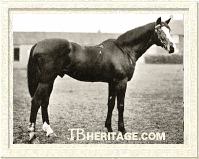
Ugly | | UGLY (1892, out of Wee Agnes, by Strathconan), a "very good-looking animal" whose name "doubtless was derived from his big, ugly lop years," raced for Frederick Glyn, (4th) Baron Wolverton, whose wealth derived from his family's bank. UGLY, at almost 17 hands, had the muscle, "with strong back and loins and immense bone" that characterized a speedy horse -- his speed, it was said, "was exceptional" -- and his owner and trainer seldom ran him in any race over six furlongs. He represented a distillation of the speed descending from Lord Lyon, running as a sprinter for seven seasons and winning twenty-two of his 47 races, specializing in the spring sprint handicaps, where he often carried the highest weight.
|
Trained by Richard Marsh at his Egerton House stables, in addition to racing UGLY served as a trial horse for Marsh's classic winning charges, Persimmon and St. Frusquin. UGLY'S most notable win was Newmarket's July Cup in 1898 over six furlongs, simply because that is the best known of the sprinter handicaps. In 1897 he won Goodwood's Singleton Plate (5-1/2 furlongs) and Lewes' De Warrenne Handicap, beating Americus, the American import who would infuse speed into the thoroughbred through his famous daughter, Americus Girl.
UGLY retired to the Egerton Stud, standing alongside Ayrshire, Cyllene, Common and St. Serf, at the low fee of 10 guineas, which made him a relatively popular sire of precocious juveniles, but unlike all of them, he is never seen among the top twenty sires in the leading stallion lists. One of his winners was the half-bred Rubicon (1909, H-B Family 2), that won the Wolverhampton Foal Plate, worth £439, a pretty good sum.
UGLY'S best runner and stallion son was Spanish Prince (1907, from Galazora, by Galleazo), another fast horse that could extend to 1-1/2 miles. Spanish Prince's sixteen wins included the 1-1/2 mile Victoria Cup at Hurst Park (1911), the July Cup (1912 and 1913), Goodwood's Rous Memorial (7-1/2 furlongs, 1912 and 1913), and the King George Stakes. Not too successful as a stallion in England, his owner, J.B. Joel sold him to American Clarence Mackay in 1917; two years later Mackay's stud was dispersed and Spanish Prince went to owner-trainer John Madden for $5,500, and installed at his Hamburg Place Stud in Kentucky. Madden bred Spanish Prince's best runner, the champion mare Princess Doreen -- the second highest money winning mare in America to her time -- although in a partnership deal with the Jones brothers he let her slip through his fingers. His other good winners included Recreation, Deeming (winner of the Kentucky Oaks), and Spanish Play (winner of the Latonia and Louisiana Derbies), and at the time of his death in 1934 he had bred winners of 953 races worth over $1.2 million. Spanish Prince was among the top twenty leading sires in the U.S. five times, and thanks to Princess Doreen, was just beaten out of first place on the list in 1925, when his progeny (34 winners) earned only a few hundred dollars less than Sweep, who had twice the number of runners that year. In 1931 (Spanish Play's three-year-old season) he almost tied with Wrack for eighth place on the list. Spanish Prince, who died in Maryland in 1934, was the end of the Lord Lyon sire line in the U.S.
The only other Minting son that was a stallion of any significance was MINOR FORFEIT (1894, out of Maibaum by Scottish Chief). A big light bay "well over 16 hands," he was somewhat upright, with straight shoulders and a bit sickle-hocked. Bred by J.H. Platt, he ran once as a juvenile before his purchase by L.E.B. Homan who sent him to South Africa to run in the principal handicaps. He wasn't exactly a world-beater on the turf there, winning six races and placing in three, his best the Johannesburg Autumn Handicap at age five, very lightly weighted. He was then purchased by George Norton for stud duty in Natal. When he got some winners from very modest mares, Henry Nourse, one of South Africa's most prominent breeders, picked him up for his Dwarsvlei Stud and after that he was consistently in the top ten leading sires in South Africa, placing first on the list in 1915-16. Like Minting and Lord Lyon, he got precocious juveniles and sprinters, but most were "deficient in stamina." His best was the great race mare Dignity (1907, from Stuck-up, by Suspender), the best filly bred in South Africa to her time, and later an excellent broodmare that produced Dignitary (South African Derby), Manners, and Decorum. He also got a number of other good winners, including Unequalled (1910, from Peerless, by Pear Diver), who made second on the sire's list behind the blockbuster stallion Polystrome in 1930-31. MINOR FORFEIT's daughters were good broodmares, and many of their lines continue to the present.
AVIDITY (1896, out of Avilon, by the versatile stallion Isonomy), Minting's only good stayer, was bred and raced by Sir Joseph Blundell Maple, a wealthy businessman and longtime M.P. for Dulwich, who owned a number of runners in the late 19th century, including classic winner Nun Nicer and her sire, the Triple Crown winner Common, the latter purchased as a stallion and used at Maple's Childwick Stud in St. Albans. AVIDITY'S wins included Doncaster's Alexandra Plate (1-1/2 miles), which he took in both 1900 and 1901, and the two mile Goodwood Stakes in 1901, with numerous placings in good handicaps. He was sold after Blundell's death and went to stud at Rathconrath Stud, Mullingar, Co. Westmeath, Ireland. He was more most useful as a jumper sire -- usually in the top twenty jumper sires in the U.K. in the teens -- getting few winners on the flat. His best flat racer was Hayden (1904), a winner of the Madrid Handicap at the Curragh as a juvenile and of Kempton Park's 1-1/2 mile Jubilee Handicap at age three. His jumping offspring included All Sorts (1910), winner of the Irish Grand National; Mask (1913), who took the important 4 mile Conyngham Cup (steeplechase), and Clonsheever (1915), a winner of the Galway Plate, a two mile handicap 'chase , in both 1923 and 1924. All three of these horses were geldings. An AVIDITY daughter, Hornet's Queen (1910), bred on, with classic winning tail-female desendants in Ireland and other countries, including 1983 Epsom Derby winner Teenoso.
MINSTEAD (1899, from Lightead, by Zealot), was bred and raced by Lord Harewood. He did not like to run a distance, but did well in mid and short distance races, winning the Middle Park Plate as a juvenile easily, and took Newmarket's Column Produce Stakes at age three, promising to be a possible classic contender. His legs starting giving him trouble, and he broke down so badly in the Newmarket Stakes he had to be retired. In the stud he was modest, at best, getting winners of about eighty races worth £19,233. He died at age twenty, leaving behind some useful broodmare daughters, notably Homestead, the dam of Pomme-de-Terre , a winner of the Great Yorkshire Stakes, Doncaster's Great Yorkshire Handicap, the Manchester Cup and Manchester November Handicap, and the Prix du President de la Republique, all 1-1/2 mile races.
Other Minting sons that were of some use on the turf included DINGLE BAY (1892), whose wins included Yorkshire's Great Ebor Handicap; MINTLAW (1891), who did not start until age four, when he won Newmarket's Biennial Stakes; the Duke of Devonshire's MINSTREL (1894), a free-striding colt that won Ascot's 6 furlong Wokingham Stakes at age four; LEGAL TENDER, winner of the Welsh Grand National Steeplechase; ROYAL MINT (1895), whose juvenile wins in France included the Prix de la Foret. ROYAL SOVEREIGN (1891), mostly used as a hunter sire, got Royal George (HB Family 6), a winner of Kempton's Great Jubilee Stakes, the Victoria Cup, and other good handicaps.
One of the few Minting daughters to do well on the racecourse was NEW GUINEA (1890, from Newhaven, by Macaroni). She won three of her four lifetime starts: Newcastle's Seaton Delaval Stakes as a juvenile, and at age three the Newmarket Oaks and Newmarket St. Leger (almost 2 miles). She bred five winners, including Goldwin, a winner on the flat and over jumps, and several other of her foals were also good over fences. At age seventeen her owner, Evan Prichard, bred her to Wargrave (by Carbine, and out of MAID OF THE MINT'S dam, Warble), a useful racehorse that won the Great Ebor Handicap, producing a filly, Queen Elizabeth II (1918). Queen Elizabeth was purchased as a yearling by Jefferson Cohn, and, unraced, ended up in his stud in France, where she produced four winners of races on the flat and over fences. The best of these was Anna Bolena (1920), by Cohn's stallion, Teddy, who won the Prix Chloe and the Poule d'Essai des Pouliches, barely failing to win the Prix de Diane. Anna Bolena was later dam of Jumbo, "a big, leggy, tearaway colt" that won the Prix Daphnis and Prix Royal Oak, and Mary Tudor (1931, by Pharos), a winner at ages two through five, including the Poule d'Essai des Pouliches, and at age four the Prix d'Harcourt over 1-1/2 miles. She, in turn, became the dam of several good winners, including Owen Tudor (1938, Epsom Derby, Ascot Gold Cup), later a useful stallion, and Chester Vase winner Edward Tudor.
Another Minting filly to hit it off early in England was Sir Joseph Blundell Maple's MINTING QUEEN (1890, out of Empress Queen, by Strathconan), promising, as it dismally turned out, unsuccessfully, that Minting would be a good stallion. She won seven good races as a juvenile, worth £4,000, including Lincoln's Brocklesby Stakes by two lengths in a canter (beating Lady Kendal and twelve others), and Liverpool's Sefton Park Plate easily, although she could not beat the colts Tibbie Shields in Sandown Park's National Breeders Produce Stakes or Lily Langtry's Milford in Chester's Royal Two Year Old Plate. She did not train on and was retired to Maple's Childwick Stud. She was consistently bred to his stallions, Common and Childwick, not the best sires, but her female line continued, barely, with winners in France and Australia through the twentieth century.
ONE I LOVE (1893, out of The Apple, by Hermit), was another of Minting's better daughters on the turf, and more importantly, her line survived the blow to American racing brought on by the anti-wagering legislation sweeping the country, by being removed to France in 1913, and then returning to the U.S. She was imported into the U.S. from England at the side of her dam, The Apple, by Col. W.P. Thompson, owner of Brookdale Stud in New Jersey.
ONE I LOVE was quite true to the form of the good Lord Lyons and Mintings -- speedy juveniles -- and it isn't surprising that her success in the speed-oriented U.S. ensured her line would continue, with many champion juveniles descending from her within the first four generations. Running for Brookdale, she was a good juvenile winner of five consecutive races in a row, including the Belles Stakes, the Partridge Stakes, the Golden Rod Stakes, and the Great Eastern Handicap, making her the crack filly of the Eastern Division in 1895. At age three she won a race for 3 year old fillies at Morris Park, then failed miserably over a mile in the Ladies Stakes at Morris Park ("the weight told its tale"), and in June succumbed to the flu, as did most of the horses that did not flee Morris Park in time. Back in training after that, she bowed both front tendons and was retired to the breeding shed.
In October of 1897 ONE I LOVE was, excepting the stallion Clifford (who was bought in by John Sanford), the highest priced horse sold at a big sale at Morris Park, which included most of the Brookdale Stud stock, since Thompson had died the previous year. She was picked up for $3,500 by John Sanford for his New York Hurricana Stud. She produced a number of foals at Hurricana, among them Love Cliff (1908) and Love Apple (1911), both fillies by the excellent runner Clifford (by Bramble, winner of 42 of 62 races). Love Cliff and Love Apple accompanied the pregnant ONE I LOVE to Sanford's stud in France in 1913 when racing in the U.S. went dark, and where she dropped Affection (1914, by Sanford's American-based stallion Isidor, by Amphion).
Sanford brought his horses back to the U.S. in 1914-15, when he and other wealthy France-based American breeders (except August Belmont) beat a path back to the States, both because racing circumstances had improved in the eastern U.S. and because the French were trying to requisition one in every two horses from American owners for the war effort. Back in the U.S., Love Cliff's tail female line was successful, and is still active: the excellent filly Optimistic Gal (1973, Alabama Stakes, Frizette Stakes, Matron Stakes, etc.), and the good handicapper Bates Motel (1979), later a useful stallion, were among her descendants.
ONE I LOVE'S French-born daughter, Affection, also came back to the U.S., running twice unplaced. She bred a series of good runners to the cover of a variety of stallions: Emotion (1919, by Friar Rock), a stakes winner and dam of the stakes winner High Strung (the Futurity, and other races worth $156,300, champion juvenile male); her sister, Heloise (1925), a winner of one race as a juvenile; Flat Iron, Escutcheon (1927, by Sir Gallahad), and Sanford, all stakes winners; and Hug Again (1931, by Stimulus), a winner of ten races for Warren Wright of Calument Farm, later dam of Sun Again (1939), a good stakes winner and later a useful stallion, and Fervent (1944), winner of the American Derby, Dixie Handicap and numerous other races.
Affection's daughter Heloise was the dam of Futurity winner and champion juvenile male Tintagel; champion juvenile filly Dinner Date; the noted sprinter Sergeant Byrne; a useful handicapper, Francesco; the speedy Boy Night, and Miss Britanny, a good juvenile (Swaps Stakes winner Clear Choice, 1983, descends from Miss Britanny).
Affection's daughter Escutcheon, dam of Kentucky Oaks winner Mars Shield, had many successful stakes winners in her tail-female line, including Belmont Stakes winners Creme Fraiche (1982) and Coastal (1976), the good stayer Meneval (1973), the outstanding Nashua filly Shuvee (1966, Acorn Stakes, Alabama Stakes, CCCA Oaks, etc.), the 1942 champion juvenile filly Smart Deb, and the excellent runner and champion three-year-old male and later good stallion Slew o' Gold (1980).
Minting's Broodmare Daughters
Minting was often among the top twenty broodmare sires in Great Britain in the first decade of the twentieth century, placing sixth in 1906 (Spearmint's three-year-old year), his highest ranking. The most noted of Minting's daughters in the breeding shed, other than ONE I LOVE and NEW GUINEA, were MAID OF THE MINT (1893), dam of Derby and Grand Prix de Paris winner Spearmint, and FANNY RELPH (1892), whose daughter, the speedy Rose Tree became the dam of the great U.S. champion Roamer.
FANNY RELPH (1892) was unraced. Her daughter by Bona Vista, Rose Tree (1896), who ran mostly at selling plate level, was fast and a weight-carrier. At age two Rose Tree won Liverpool's Tyro Stakes and two other races, and placed second three times in eleven starts. At age four her wins included Newmarket's Bretby Handicap and Heath Stakes and placed six times in seven other starts, and at age five she won Ascot's Wokingham Stakes. Claimed by American Ed Corrigan, Rose Tree went to the U.S. In 1911 she dropped the great Roamer, a winner of 39 races in 98 starts, including the Travers, Brooklyn Derby, Saratoga Cup, who established a new record for a mile in 1918.
|
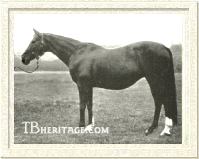
Maid of the Mint
| | MAID OF THE MINT (1893) was a non-winning mare out of Warble, by the King Tom son, Skylark. Purchased for £2,000 by Sir Tatton Sykes in foal to Carbine, she went to his Sledmere Stud to foal out her first colt, Spearmint, in 1903.
Sold as a yearling to Maj. Eustace Loder, Spearmint won one race as a juvenile in three starts. Not originally intended for the Derby -- Flair, who injured herself two weeks out was the stable's candidate -- he was brought up as the second string and tried with older stablesmates, the great mares Pretty Polly and Hammerkop, where he showed excellent form.
|
Spearmint went on to win the Derby in record time, and then was taken to France to run in the Grand Prix de Paris, the race for which he had been intended from the early spring. He won that race, the first English horse to do so since his grandsire, Minting had so thoroughly trounced the French horses, but the running of it ruined his legs and he never again saw a race course.
Spearmint, at Loder's stud in Ireland, was among the leading sires in Great Britain, except for the war years. He got Spion Kop, a Derby winner, and St. Leger winner Royal Lancer, and a number of good fillies that went on to become successful broodmares, including the great matron Plucky Liege.
Other Minting daughters useful in the breeding shed are listed below.
ANDROMEDA (1890, from Stella, by Mogador), was another pretty much useless horse on the turf, starting once and unplaced at age two. However, in the stud she produced several winners, including Goodwood Cup winner Perseus (1899, by St. Simon) and his sister, The Gorgon (1897), a winner of Ascot's New Stakes. The Gorgon, dam of Two Thousand Guineas winner Gorgos (1903, by Ladas), also had several daughters that bred on; The speedy Nebbiolo (1974), a winner of the Two Thousand Guineas in 1977, was one of her descendants.
|
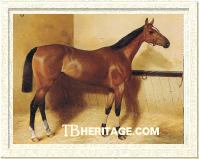
Lady Minting
| | LADY MINTING (1891) was out of Virginia Shore, by John Davis (by Voltigeur), a very good staying winner of ten races, including the Great Yorkshire Stakes and the Great Northamptonshire Stakes. LADY MINTING was a useful race mare that ran second to Amiable in the One Thousand Guineas and that year won the second year of the First Clarence and Avondale Stakes at Sandown Park (1 mile-1 furlong), worth the goodly sum of 2,500 sovereigns.
LADY MINTING produced some winners for her owner, Mr. Russel, including Lady Min, a winner of three races.
|
In 1903 William Allison, then acting as a bloodstock agent, purchased LADY MINTING in foal to Collar and her yearling filly for American James R. Keene (owner of Domino), and she was sent to Keene's Castleton Farm in Kentucky. LADY MINTING'S tail-female line is still producing stakes winners in the U.S. LADY MINTING'S half-sister, Dusky Queen (1897, by St. Simon), produced the non-winner MINNEKOTA (1903, by Minting), whose tail-female line is also still active.
|
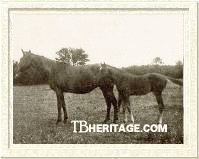
Galingale
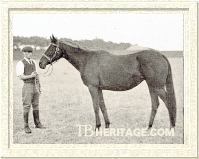
Meadow Chat
| | GALINGALE (1891) out of Gale, by Galopin, was placed twice in six starts as a juvenile, and at age three won Nottingham's Welbeck Abbey Stakes in six races. A "mare of great quality," she passed through several hands as a broodmare, spending some years in the Zetland stud in Yorkshire before her purchase at auction in 1897 by Henry Greer and taken to his stud in Ireland. Her daughter Water Lily (1898, by Ocean Wave) was also a winner, and in Germany, where her tail-female line continued, was the dam of winners, including Waldkatze (1905, by Gallinule), who took the Preis der Diana. GALINGALE'S son, Galangal (1902, by Gallinule), won Doncaster's Champagne Stakes as a juvenile, and her son Game Fowler (1905, by Gallinule's son Wildfowler) won the Irish Cesarewitch at age seven.
MEADOW CHAT (1892), out of Cesarewitch winner Stone Clink (1882, by Speculum) won the Newcastle Park Plate and placed three times at age three in six starts. She was one of the more productive of the twelve to seventeen mares at King Edward VII's Royal Stud at Sandringham. Her son Mead (1900, by Persimmon), not quite top class, won six races, including Goodwood's Richmond Stakes as a juvenile, the Prince of Wales's Stakes (13 furlongs) at Ascot at age three, and the two-mile Jockey Club Cup at Newmarket at age five.
|
Mead was purchased by the Criadero de Pirque for £2,000 and imported into Chile. He bred some good winners, among them Menina (1908, winner of five of 21 races ages 2 through 4), Iscariote (1909, winner of El Ensayo), St. Mead (1909, a good handicapper, winner of ten races in 29 starts) and his brother St. Andrew (1910, winner of seven races in 18 starts, including the Raimundo ValÈs Cuevas), Celosia (1910, winner of six races, including the Criadores and the Juan S. Jackson), Cybelle (1910, a winner of La Prueba), and Ugolin (1916, Polla de Potrillos and El Ensayo, later a minor stallion).
MEADOW CHAT'S son, Chatsworth (1901, by Persimmon), was a winner of several races, including the Newmarket St. Leger and Newmarket's Lowther Stakes, and was second in the Goodwood Cup to Saltpetre. Her daughter, Ecila (1899, by Persimmon), retained as a broodmare at Sandringham, produced Princesse de Galles (1906, by Gallinule), winner of four of her six races as a juvenile --including Newmarket's Chesterfield Stakes and Goodwood's New Ham Stakes --and at age three, second to Electra in the One Thousand Guienas and, while ill, to Perola in the Epsom Oaks, and later took Ascot's Coronation Stakes easily. Ecila, a non-winner, was also the second dam of the excellent German runner and good sire, Ossian (1918, by Fels), and his half-sister Ostrea (1921), winner of the Preis der Diane. Ecila's tail-female line continued into the late twentieth century through Princesse de Galles and Sweet Alison (1908, by Thrush).
MEADOW CHAT'S daughter Saints' Mead (1906, by St. Simon), a very modest winner of Epsom's North Park Stakes, produced five winners, including Runnymede (1922), a winner of Chester's Dee Stakes and Newmarket's July Stakes, and Stained Glass (1917), the dam of One Thousand Guineas winner Scuttle, who continued the female line to the present.
GLAVE (1893, out of Gloria, by Rosicrucian), bred by Vyner, ran six times as a juvenile and did not win. She was sold to France, where she produced five winners. Her son Ob (1901, by Bocage) won the Grand Criterium and Baden Baden's Zukunfts Rennen, and in England took the Lincolnshire Handicap in both 1906 and 1907. Her daughter, Gourouli (1907, by St. Damien) raced in England, where she won Newmarket's Fitzwilliam Stakes, and later produced Pondoland (1919, by Pommern), a not-quite top class colt that won five races as a juvenile, including Ascot's Coventry Stakes, and at ages three through five the Newmarket Stakes, Sandown's Anniversary Cup and Goodwood's Drayton Handicap. GLAVE'S sister, GLORIOLA (1890) was the dam of Union Jack (1900, by Suspender), a winner of Goodwood's Chesterfield Cup.
CRAIGMADDIE (1893, from Kate Craig by Craig Millar) was another Minting that couldn't get more than a mile. She was second once in three starts as a juvenile. At age three she won three minor races in eight starts -- Newcastle's Park Plate, Hamilton's Licensed Victuallers' Handicap, and the Harry Fowler Handicap at Stockton; her daughter, Mariota (1912, by St. Victrix), was at about the same level, winning the Salisbury Plate and Newmarket's October Nursery Handicap in six starts at age two, and unplaced at age three. Mariota's grandaughter, however, Taj Mah (1926, by Lemberg), bred by the Aga Khan in Ireland and sold at the Deauville sales in France for £2,000 to Simon Guthmann, won the One Thousand Guineas. Taj Mah's half-sister, Taj Shirin (1927, by Gainsborough) -- dam of Chester Vase and Princess of Wales's Stakes winner Taj Akbar (1933) and of Irish Derby winner Nathoo -- continued the female line.
The unraced MINO (1893, out of Buy a Broom by Wisdom), was the dam of Minnow (1905, by William the Third), a one-race winner, and of Croila (1908, by Mackintosh), both of which had long-lived tail-female lines. One of MINO'S descendants in tail-female was Bellini (1937), an unbeaten three-year-old winner of the Italian Derby, and of thirteen other races in eighteen starts, and later sire of Tenerani, who got the great Ribot.
CROSS ROADS (1901, out of Hari-Kari, by Marcion), yet another Minting filly bred by Vyner that ran at selling plate level, placed four times in ten starts at age two, and at age three won the Park Plate at Folkstone, placing five times in eight races. She was later third dam of Bahadour (1919, by Sardanapale), a good winner in France; Bahadour's half-sister Guerriere (1914) was second dam of Kentucky Derby winner Broker's Tip. CCA Oaks winner Bramalea (1959), the dam of Epsom Derby winner Roberto (1969) descended from CROSS ROADS in tail-female.
MINTBERIA (1904, from Beria, by Vyner's stallion Crowberry) and MINTLESS (1906, from Gorseberry by Crowberry) were close relatives-in-blood; Beria and Gorseberry's dam, Sardonis, were both out of Sophia, by Marcion (dam of the good stallion Hagioscope). Both fillies were bred at Vyner's Fairfield Stud. MINTBERIA produced Meissonier (1918, by Irish Lad), a winner of the Prix Noialles for Arthur Veil-Picard; he was put over fences, and in 1925 was second to Mon Petit ( a winner of the Grand Steeplechase de Paris) in the Grand Prix de la Ville de Nice (4 miles, worth 150,000 francs), and winning the Prix Murat at Auteuil, another important chase (4400 meters), worth 50,000 francs. MINTLESS, purchased as a yearling by Tom Corns, ran once, unplaced, as a juvenile. At the Newmarket December sales in 1915, in foal to Lonawand, she was purchased for 300 guineas by William Allison for Virginian T.F. Ryan. She was shipped to the U.S., and installed at Ryan's Oak Ridge Stud, where she dropped Minawand, a minor winner later purchased by Col E.R. Bradley, who bred her to Bubbling Over; the result was Burgoo King, winner of the Kentucky Derby and Preakness Stakes in 1932.
Other Minting daughters that produced winners included SEDGE (1893, sister to MEADOW CHAT), the dam of Whistling Crow (by Crowberry), a winner of the 1-1/2 mile Newmarket October Handicap; MEMNE (dam of Melete, a winner of three races), SANTA MANA (1890, out of Pinta, by Adventurer), dam of Santa Regala, a winner of three races. A number of his daughters bred on, part of a chain that led to later winners in tail-female, such as ECHLINE (1893), that ran second in the Cheveley Park Stakes as a juvenile, and won the Corporation Maiden Plate at Yarmouth at age three, but was pretty much in the same class as most of Minting's other fillies. Long down the line of descent, she had Preis du Feu (1955), a winner of the Poule d'Essai des Poulains and other races in France.
--Patricia Erigero
Thanks to Tim Cox for assistance with Minting's race career
|
|
|
|

